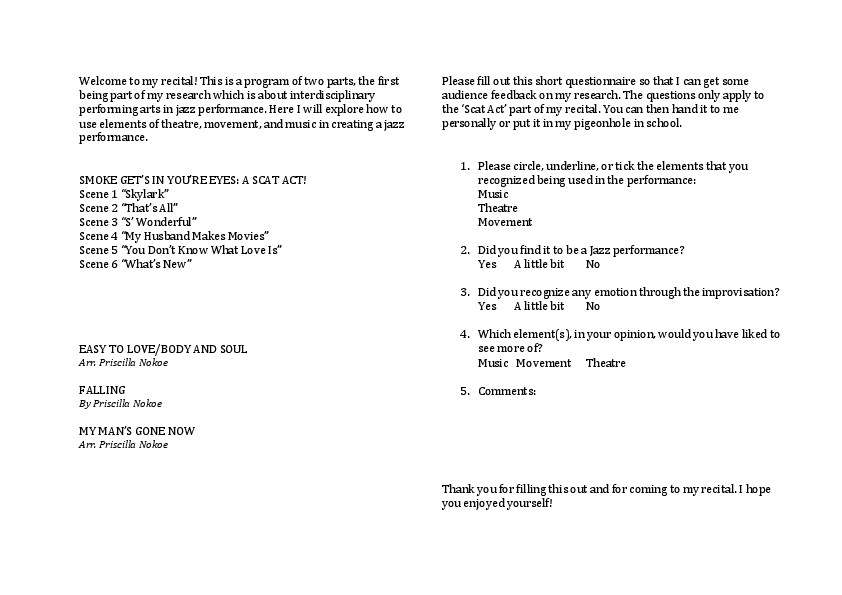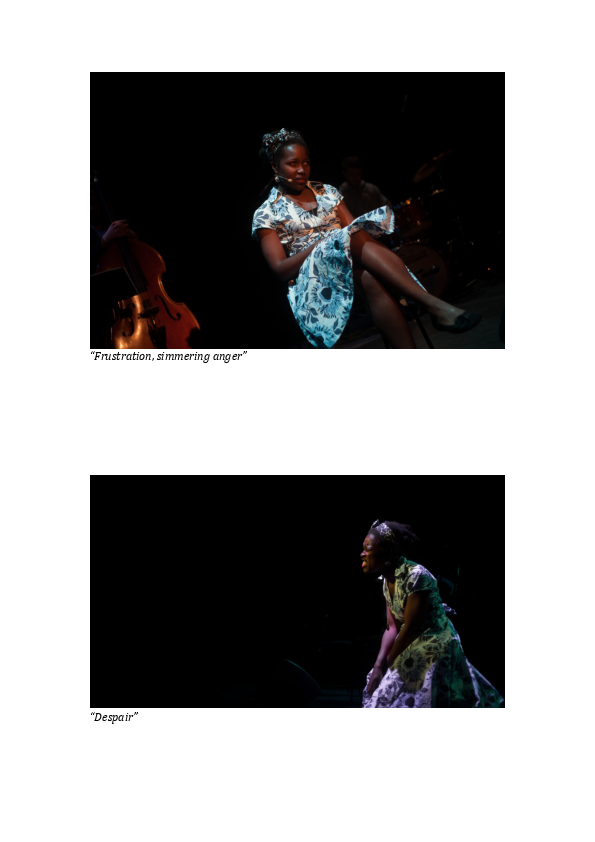From the 50 that I printed out, I only got back 8. Here are the results of the feedback:
1. Please indicate the Element(s) recognized:
Music – 6
Theatre – 7
Movement – 5
One person didn’t answer the question
2. Did you find it to be a jazz performance?
Yes – 8
A little bit – 0
No – 0
3. Did you recognize any emotion through the improvisation?
Yes – 4 (one added “absolutely”)
A little bit – 4
No – 0
4. Which element(s) would you have liked to see more of?
Music – 2
Movement – 3
Theatre – 1
One person wrote “none, you have found the right balance”
I found the results to be interesting and very helpful. That half of the people said they recognized the emotions “a little bit” meant that I would have to work on my acting skills more. I already had an idea what of how some of the feedback would be like (for example, wanting to see more movement), but what did surprised me was that everyone identified the performance as being a jazz performance. I was on the right track!I also had the answer to one of the questions that I had, which was if scatting could be theatrical. Apparently it can.
Going Forward
With information gathered from literature, interviews, and feedback from the audience, I can now start to plan for the final performance, knowing the areas that I need to work on. Aside from the challenge of communicating emotions clearly through scat, the other challenge presented is how to incorporate elements of dance in a jazz performance. Of course, I could make a comeback of the 20’s and just add dancers who would dance the style of that time to the music. However this is not the solution I am looking for. I am looking for ways to make dance, and its elements, an integral part of the performance, instead of something that is just being ‘slapped’ on top of it. One possible solution I have thought of is exploring dance improvisation as a meeting point to musical improvisation. The musician’s improvisation can be inspired or guided by the dancer’s movements and visa versa. Another idea is to use dancers as characters in a song; their dance movements telling the story in the place of text.
Other challenges that I want to tackle are, how to have more audience participation in a performance. This falls in line with breaking modern western music performing customs. In my culture, it is normal that the audience is active in the performance. The hall is very rarely silent or still. Audience members shout reactions and comments to what is happening on stage in a theatrical performance. At certain times in a dance performance, the audience members are free to go into the circle and dance. If an audience member knows how to play an instrument, they can join the musicians in playing or even replace one of the musicians to give that person a break. This is something I have never seen in a traditional western performance, and specifically in a jazz performance. I would like break this “fourth wall” to explore ways in which perhaps the audience is able to add to the music itself, and in turn to the performance as a whole.
EXPERIMENTATION/ IMPLEMENTATION
I wanted to use the first year master exam to experiment a little with theatrics, movement around the stage, and perhaps even usage of props, which is usually not found in the traditional jazz performance. I felt that this was a good stepping-stone for me towards my final goal, which is to perhaps incorporate real dancers and use my own compositions to create an interdisciplinary jazz performance.
My first plan that I had was that the setting would be a bar (which would explain the musicians presence). I was a narrator or sorts, speaking and singing directly to the audience about the people that I got to meet being a bartender. Imitating them in jazz standards. Characters would walk in and out of the bar. There would be usage of props and costumes; I would make use of the space on the stage. I thought that it was a good idea but one of my coaches made me realize that it was mono-dimensional and that maybe we could come up with a better idea.
The idea that we came up with was a scat act! I would go through the time line of a relationship, using vocal improvisation/scat singing to portray the different emotions in the architecture of a relationship. Each scene/ scat had a jazz standard or song that best represented the emotion or stage of the relationship. However, the scatting throughout was based on the chord progressions of the jazz standard ‘Smoke get’s in your eyes’. The lyrics of this song would only be sung finally at the end of the whole act. Below is an outline I made for the musicians, with the words added which expressed the emotion and energy that I had in mind for each scat.
SMOKE GET’S IN YOUR EYES: A SCAT ACT!
Scat 1: “Hopeful yearning”
- I say the date
- Bass plays melody of B-section of “Smoke get’s in your eyes” (not in time) twice.
- Piano joins in the second time of the B-part with chords
- Whole band starts playing A-section “Skylark” in ballad tempo
Scat 2: “Eager with high energy”
- I say the date
- Soft brushes fast swing very quietly
- When I jump of the chair, bass and piano play C7 chord 4 times (quietly to loud), then we start playing “That’s All” till end of B-section
- In bar 17 we go into half time and end.
Scat 3: “Content happiness”
- I say the date
- Bass and Drums play a medium bossa nova groove. Chords used are the first two chords of “Smoke get’s in your eyes”
- On cue, piano comes in with first chord of “S’ wonderful”
- We play “S’ wonderful” once through.
Scat 4: “Frustration, simmering anger”
- I say the date
- Piano plays first 3 chords of “Smoke get’s in your eyes” but with B-flat minor as first chord, giving lots of space and silences
- I put my head back and that is the cue to start “My Husband Makes Movies”
Scat 5: “Despair, anger”
- I kick the chair and say the date.
- After I say the date, we start some free jazz stuff!
- The emotion here is anger
- The words I will improvise on is “You don’t know what love is”
- When I say the word “is”, that is when we stop
Scat 6: “Awkwardness, closed”
- I say the date and scat alone
- When I start walking, we start “What’s new” from bar 25 (with an upbeat)
- We end song and go into bar 22 of “Smoke Get’s In your eyes”
- We play “Smoke get’s in your eyes to the ending.
I also used my recital as an opportunity to gain feed back from the audience. In my program sheet, I made a short questionnaire, which I asked everyone to fill in and hand back to me. I was curious to see if I was successful in what I was trying to do, and how the audience perceived the performance.



